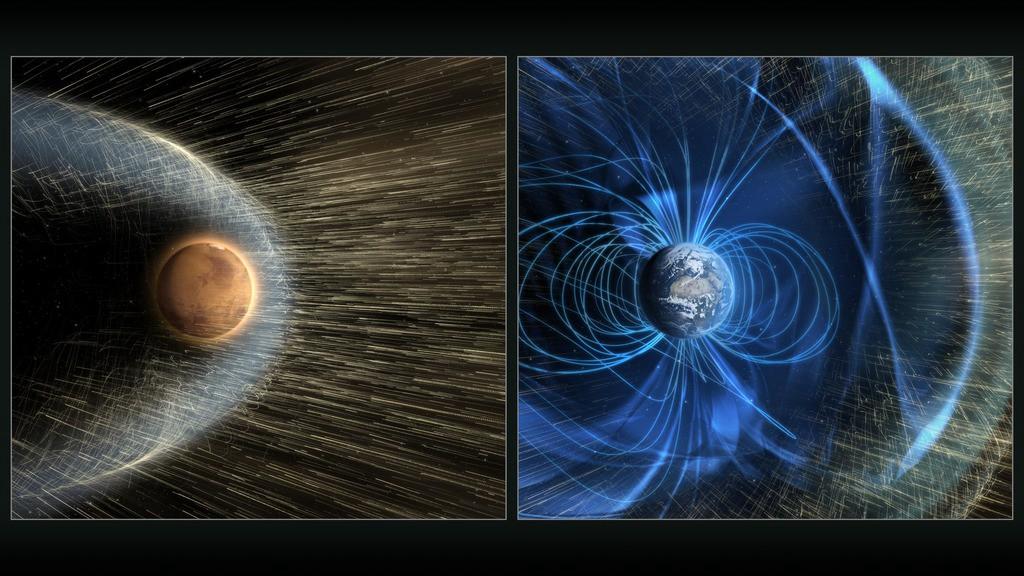When the Mariner 9 flew past Mars in 1972, scientists were treated to the first evidence that water once flowed on the surface of Mars. Subsequent missions confirmed this theory based on the study of features that form in the presence of water (flow channels, delta fans, and sedimentary deposits), the presence of hydrated minerals and clays in impact basins, and the discovery of subsurface ice and permafrost across the planet. These findings indicate that Mars once had an atmosphere thick enough to maintain temperatures to maintain surface water in a liquid state.
This has led to the mystery of how and when Mars lost its atmosphere, causing it to become a freezing, dry planet. Based on data collected by NASA's Mars Atmosphere and Volatile EvolutioN (MAVEN) mission, scientists have theorized that atmospheric loss involves "sputtering" - a form of space weathering where charged particles crash into Mars' atmosphere, causing other particles to be ejected into space. In a recent NASA-supported study, a team of astrophysicists consulted nine years of MAVEN data and determined that this process continues to this day.
The study was led by Shannon M. Curry, an Associate Professor with the Laboratory for Atmospheric and Space Physics (LASP) at the University of Colorado Boulder and the current Principal Investigator of the MAVEN mission. She was joined by colleagues from LASP, the Space Sciences Laboratory (SSL) at UC Berkeley, the Laboratory for Atmospheres, Observations, and Space (LATMOS), the University of Iowa, and the NASA Goddard Spaceflight Center (NGSC). The paper that details their findings was published in Science Advances.
 Mars, the red planet, has no magnetic field to protect it from the solar wind, meaning it loses its atmosphere in a way that Earth doesn't. Image credit: NASA/GSFC.
Mars, the red planet, has no magnetic field to protect it from the solar wind, meaning it loses its atmosphere in a way that Earth doesn't. Image credit: NASA/GSFC.
Based on the abundant evidence of flowing water, scientists surmise that atmospheric pressure on Mars was once much higher. Understanding how Mars' atmosphere evolved through space weathering is crucial to understanding how and when Mars transitioned from a habitable environment to what it is today. While Earth's atmosphere is subject to weathering, the process is significantly different since Mars does not have a protective magnetosphere. This means solar wind interacts directly with the planet's upper atmosphere, ionizing particles that can be accelerated to the point that they escape to space.
They can also be accelerated toward the planet and precipitate back into the atmosphere, colliding with other particles and transferring enough energy for them to exceed their escape velocity - a process known as "sputtering." While atmospheric loss is dominated by photochemical and thermal escape today, it has been proposed that sputtering was the primary escape process billions of years ago when solar activity was much higher than it is today. "We had seen a few instances of sputtering during solar storms, but to see it happening on a day-to-day basis, we needed to get coverage all over the planet and at different times of the day, which took the spacecraft almost a decade to do," Prof. Curry explained via email.
To obtain direct evidence of modern-day sputtering and determine the rate at which it occurs, Curry and her team analyzed nine years of data obtained by MAVEN's instrument suite. While several models of this process have been produced, these have focused on elemental oxygen, oxygen gas (O2), and carbon dioxide (CO2). These highly reactive constituents make it extremely challenging to distinguish sputtering from photochemical reactions. Instead, Curry and her team focused on argon (Ar) densities in Mars' atmosphere. By correlating argon densities with solar electric fields, Curry and her colleagues obtained the first direct observations of present-day sputtering. Said Curry:
Sputtering can occur in many places, including on surfaces, so we know the general process exists. We also found evidence that atmospheric sputtering was operating at Mars because of argon isotopes. Basically, lighter isotopes sit higher in the atmosphere and heavier isotopes sit further down so sputtering removed more of the lighter isotopes than heavy ones, which we saw in the data. Our results show that sputtering is occurring almost 4x more than previously thought so we will need to better understand the physics in our models to account for this. It's a huge result that could very well be the main pathway for the Martian atmosphere escaped over time.
 Artist's impression of Valles Marineris, as seen from orbit. Credit: NASA
Artist's impression of Valles Marineris, as seen from orbit. Credit: NASA
Curry and her team also present evidence of enhanced sputtering during solar storms, which could provide insight into the early Solar System when conditions were more intense. Establishing the role of sputtering with direct observations is essential to understanding the conditions that once allowed Mars to be a warmer, wetter place.
By obtaining the first observational evidence of this process, these findings could have significant implications for atmospheric models of Mars and planetary habitability.
Further Reading: Science Advances

